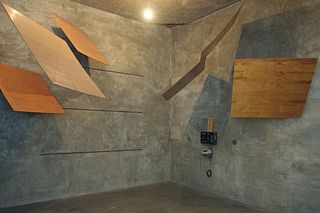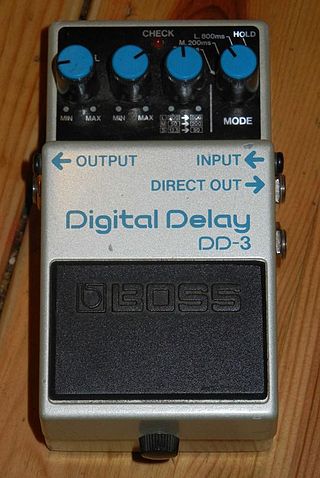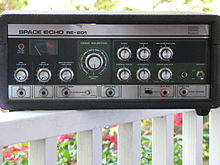
An effects unit, effects processor, or effects pedal is an electronic device that alters the sound of a musical instrument or other audio source through audio signal processing.

Roland Corporation is a Japanese multinational manufacturer of electronic musical instruments, electronic equipment, and software. It was founded by Ikutaro Kakehashi in Osaka on 18 April 1972. In 2005, its headquarters relocated to Hamamatsu in Shizuoka Prefecture. It has factories in Malaysia, Taiwan, Japan, and the United States. As of December 2022, it employed 2,783 people. In 2014, it was subject to a management buyout by its CEO, Junichi Miki, supported by Taiyo Pacific Partners.

An echo chamber is a hollow enclosure used to produce reverberation, usually for recording purposes. A traditional echo chamber is covered in highly acoustically reflective surfaces. By using directional microphones pointed away from the speakers, echo capture is maximized. Some portions of the room can be moved to vary the room's decay time. Nowadays, effects units are more widely used to create such effects, but echo chambers are still used today, such as the famous echo chambers at Capitol Studios.

Boss is a manufacturer of effects pedals for electric guitar and bass guitar. It is a division of the Roland Corporation, a Japanese manufacturer that specializes in musical equipment and accessories. For many years Boss has manufactured a wide range of products related to effects processing for guitars, including "compact" and "twin" effects pedals, multi-effect pedals, electronic tuners and pedal boards. In more recent times, Boss expanded their product range by including digital studios, rhythm machines, samplers and other electronic music equipment. They also are now manufacturing solid-state amplifiers and speaker heads such as the Waza and the Katana. Both feature multi-effects units meant to emulate Boss' classic effects pedals.

Scholz Research & Development, Inc. was the name of the company founded by musician and engineer Tom Scholz to design and manufacture music technology products.
Ikutaro Kakehashi, also known by the nickname Taro, was a Japanese engineer, inventor, and entrepreneur. He founded the musical instrument manufacturers Ace Tone, Roland Corporation and Boss Corporation, and the audiovisual electronics company ATV Corporation.
Morley Pedals is the name of a guitar effects pedal company, famous for manufacturing wah-wah pedals and other treadle type effects for guitar. Morley pedals use electro-optical circuitry rather than a potentiometer to control the effect. The foot treadle controls a shutter inside the pedal that in turn controls the amount of light reaching a photoresistor. The advantage to this system is that there are no potentiometers in the signal path to wear out and become "scratchy sounding" over time. Electro-optical circuitry is used throughout the classic Morley pedal line, which includes or has included volume pedals, delay pedals, chorus and phaser pedals, and many others.
A phaser is an electronic sound processor used to filter a signal by creating a series of peaks and troughs in the frequency spectrum. The position of the peaks and troughs of the waveform being affected is typically modulated by an internal low-frequency oscillator so that they vary over time, creating a sweeping effect.

Electro-Harmonix is a New York City-based company that makes electronic audio processors and sells rebranded vacuum tubes. The company was founded by Mike Matthews in 1968. It is best known for a series of guitar effects pedals introduced in the 1970s and 1990s. EHX also made a line of guitars in the 1970s.
Chorus is an audio effect that occurs when individual sounds with approximately the same time, and very similar pitches, converge. While similar sounds coming from multiple sources can occur naturally, as in the case of a choir or string orchestra, it can also be simulated using an electronic effects unit or signal processing device.

Ace Electronic Industries Inc., or Ace Tone, was a manufacturer of electronic musical instruments, including electronic organs, analogue drum machines, and electronic drums, as well as amplifiers and effects pedals. Founded in 1960 by Ikutaro Kakehashi with an investment by Sakata Shokai, Ace Tone can be considered an early incarnation of the Roland Corporation, which was also founded by Kakehashi. Ace Tone began manufacturing amplifiers in 1963.

Delay is an audio signal processing technique that records an input signal to a storage medium and then plays it back after a period of time. When the delayed playback is mixed with the live audio, it creates an echo-like effect, whereby the original audio is heard followed by the delayed audio. The delayed signal may be played back multiple times, or fed back into the recording, to create the sound of a repeating, decaying echo.

The Echoplex is a tape delay effects unit, first made in 1959. Designed by engineer Mike Battle, the Echoplex set a standard for the effect in the 1960s; according to Michael Dregni, it is still regarded as "the standard by which everything else is measured." Used by some of the most notable electric guitar players of the 1960s and 1970s, original Echoplexes are highly sought after.
Re-amping is a process often used in multitrack recording in which a recorded signal is routed back out of the editing environment and run through external processing using effects units and then into a guitar amplifier and a guitar speaker cabinet or a reverb chamber. Originally, the technique was used mostly for electric guitars: it facilitates a separation of guitar playing from guitar amplifier processing—a previously recorded audio program is played back and re-recorded at a later time for the purpose of adding effects, ambiance such as reverb or echo, and the tone shaping imbued by certain amps and cabinets. The technique has since evolved over the 2000s to include many other applications. Re-amping can also be applied to other instruments and program, such as recorded drums, synthesizers, and virtual instruments.

The Roland U-20 is a PCM-sample synthesizer, released by Roland in 1989. It was the keyboard version of the U-220 rack module, which was in turn a similar follow-up product to Roland's U-110 rack module of 1988.

TC Electronic is a Danish audio equipment company that designs and imports guitar effects, bass amplification, computer audio interfaces, audio plug-in software, live sound equalisers, studio and post-production equipment, studio effect processors, and broadcast loudness processors and meters. In August 2015, the company was purchased by Music Group, a holding company chaired by Uli Behringer.
Del Casher is an American guitarist and inventor. He invented the wah-wah pedal, the Ecco-Fonic, and the Fender Electronic Echo Chamber. He was the first to introduce the Roland Guitar Synthesizer for the Roland Corporation.

Roland Jazz Chorus is the name given to a series of solid-state instrument amplifiers produced by the Roland Corporation in Japan since 1975. Its name comes from its built-in analog chorus effect. The Jazz Chorus series became increasingly popular in the late 1970s and early 1980s new wave and post-punk scenes because of its clean yet powerful sound, durability and relatively low cost when compared to the more commonly used tube amplifiers of the time such as Marshall or Fender. It also found favour amongst funk players in America. It also became popular to use for clean tones in heavy metal, with the most famous users being James Hetfield and Kirk Hammett from Metallica, and Wes Borland from Limp Bizkit.
The timeline of music technology provides the major dates in the history of electric music technologies inventions from the 1800s to the early 1900s and electronic and digital music technologies from 1874 to the 2010s.
The Watkins Copicat is an effects unit that produces tape delay and reverb effects. One of the first commercially available tape delay units, the original Copicat model was produced by Watkins Electric Music beginning in 1958. The Copicat became one of Watkins' most successful products, and the company produced various Copicat models and versions over the following decades.














